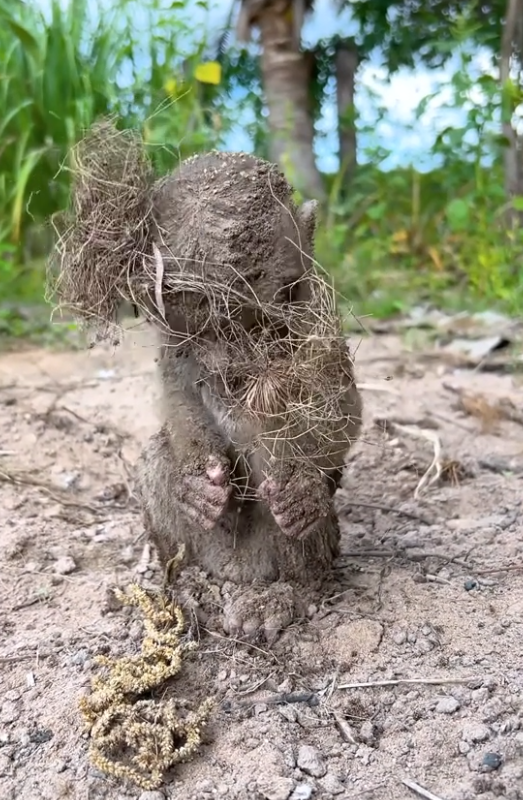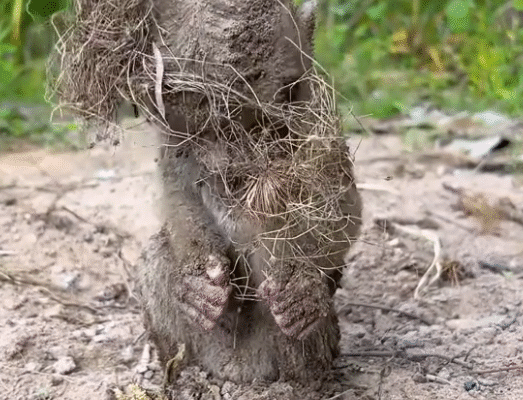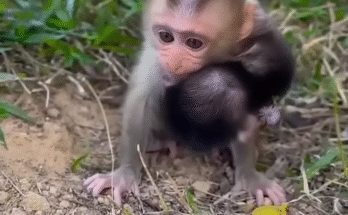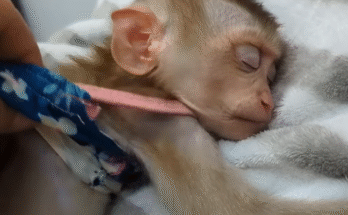In the heart of a lush forest near the edge of a quiet village, something heartbreaking was unfolding. A baby monkey, barely old enough to climb trees, lay helpless on the forest floor. His small body was coated in dust, leaves, and mud. His tiny arms trembled with exhaustion, and his bright eyes—usually so full of curiosity and energy—were now dim and glassy. He had clearly been through something traumatic.
This was no place for a baby. The jungle, while beautiful, can also be unforgiving. Predators roam, and without the protection of a troop or a mother, a lone baby monkey stands little chance of survival.

Locals from the nearby village had first heard faint cries in the early morning. At first, most assumed it was just the usual sound of monkeys calling from the trees. But one elderly man, Mr. Dara, thought differently. “Those aren’t the cries of a normal monkey,” he said to his grandson. “That’s a baby, and it sounds like he’s in trouble.”
Armed with a flashlight and a bag of bananas, the two trekked into the forest. The cries grew louder as they approached a thicket near the old stream. And then they saw him—curled up next to a fallen tree, too weak to move, covered in a thick layer of dirt and matted fur. His breathing was shallow, and his face was streaked with dried tears and mud.
The boy gasped. “He’s just a baby, Grandpa! Where’s his mom?”
That was the question no one could answer. The baby might have fallen from a tree during a storm, or perhaps he had gotten separated from his troop. Worse still, poachers may have taken his mother. In recent years, illegal animal trading had devastated local monkey populations.
Whatever the cause, this baby was alone—and he needed help fast.
Mr. Dara gently wrapped the monkey in a soft cloth he had brought for carrying firewood. The monkey didn’t resist. His tiny fingers gripped the edge of the fabric, and he let out the softest whimper, as if he knew someone was finally there to help.
Back at the village, they cleaned the monkey with warm water, picking out twigs and insects from his fur. The monkey’s skin underneath was raw in some places, evidence of scratches and insect bites.
The villagers quickly grew attached to him. They named him “Chenda,” which means “thoughtful moon” in Khmer, because of the way he looked up at the sky, silent and still, as if searching for something—or someone.
Chenda was given warm milk through a syringe at first. His body was so weak that he could barely sip. But over time, with care and attention, he began to regain strength. His tiny tail started flicking again, and his once-dull eyes began to sparkle.
However, recovery wasn’t just physical. Chenda had suffered emotionally. He often woke up crying, hugging his cloth tightly. If anyone moved too quickly or raised their voice, he would cower in fear.
The village children began sitting by his side daily, reading to him, playing gentle music, and offering small treats like slices of banana and soft papaya. Over the weeks, Chenda began to trust again. He learned to climb short wooden ladders made by the villagers, and he even began mimicking the way people waved or clapped.
But even in his healing, there was sadness. Chenda was still a wild animal, and everyone knew he couldn’t stay in the village forever. He needed to be with his own kind. The community reached out to a nearby wildlife rescue center known for rehabilitating monkeys and returning them to the wild.
When the rescue team arrived, Chenda had just started swinging on a low rope hung between two poles. He looked vibrant, playful, and far from the dirt-covered, lifeless creature they had first discovered.
The farewell was emotional. Mr. Dara gave him one last hug and whispered, “Be strong, little one. Find your family. Or make a new one.”
At the center, Chenda was introduced to other young monkeys who had faced similar fates. Some had lost their parents. Others had been rescued from cages or black-market dealers. Together, they formed a new kind of family.
Chenda flourished. The caretakers noted his gentle nature and his instinct to comfort the other babies. He became a sort of big brother figure, always the first to reach out when one was scared or alone.
Months passed. The forest around the rehabilitation center became a training ground. The monkeys learned to forage, swing high among the trees, and recognize dangers. Slowly, they were prepared for release.
The day finally came. A team of experts, including villagers from Chenda’s old home, joined the release operation. A special protected zone deep in the jungle was selected. The gate to the transport cage opened, and for a brief moment, Chenda looked back—just a second—before leaping onto a branch and disappearing into the canopy.
He was home.
The villagers still speak of him often. Children draw pictures of Chenda and tell stories of his rescue. Mr. Dara keeps a framed photo of the moment Chenda first drank milk from the syringe. “He reminded us that no life is too small to save,” he says with pride.
In the end, what began as a tragedy—a helpless, dirt-covered baby monkey left alone in the forest—became a symbol of hope, compassion, and second chances. Chenda’s story continues to inspire, reminding us all that even the weakest can grow strong again, with love and care.
And somewhere, in the heart of the jungle, a young monkey climbs trees under the moonlight, free and fearless—because someone once chose to listen to a cry in the dark. 🐒💔🌙



